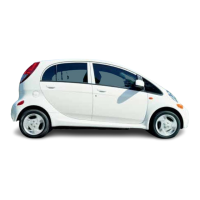6-14
Chapter 6 Emissions control systems
7.33 Disconnect the vacuum hose from the throttle body EGR
vacuum nipple and hook up a hand-held vacuum pump in
its place
7.41 Measure the resistance of the temperature sensor at the
temperafures specified in the text
illustration).
With the engine at idle, apply avacuum of 9.4 in-Hg and note
whether the engine stalls or idles roughly (it should).
32 If there’s a problem, proceed to the next Step.
EGR valve control vacuum
Refer to illustration 7.33
33 The engine should be warmed up for this test. Disconnect the vacuum
hose from the throttle body EGR vacuum nipple
(see illustration)
and
hook up a hand vacuum pump in its place.
34 Start the engine, race the engine and verify that vacuum risesin pro-
portion to the rise in engine speed.
35 If it doesn’t, the port in the throttle body may be clogged and require
cleaning.
EGR valve
Refer to illustration 7.38
36 Remove the EGR valve and, through the open portion underneath,
check the diaphragm for sticking. Look for carbon deposits inside the
valve. If the valve is dirty, or the diaphragm is stuck, clean the valve with
solvent and check it again. If it’s still sticking, or clogged, replace it.
7.38 Apply less than 1.2 in-Hg and try to blow through the valve
-you shouldn’t be able to; now apply 9.5 or more in-Hg and try to
blow through the valve again -this time you should be able to
7.44 Disconnect the vacuum hose with the yellow and green
stripes from the solenoid valve and connect a hand-operated
vacuum pump in its place
37 Hook up a hand-operated vacuum pump to the EGR valve, apply a
vacuum of 10 in-Hg and note whether the diaphragm leaks (the valve
should hold the vacuum).
38 Release the vacuum applied in the previous Step. Apply less than 1.2
in-Hg and try to blow through the valve-you shouldn’t be able to; now ap-
ply 9.5 or more in-Hg and try to blow through the valve again-this time you
should be able to
(see illustration).
39 Install the EGR vaTve. Use a new gasket and tighten the EGR valve
mounting bolts to the torque listed in this Chapter’s Specifications.
EGR temperature sensor
Refer to illustration 7.4 1
40 Remove the EGR temperature sensor and place it in a pot of water:
Use a thermometer to monitor the water temperature.
41 As you bring the water to a boil, measure the resistance between terr
minals 1 and
2 (see illustration).
Up to about 122-degrees F, the resis-
tance between the terminals should be between 60 and 83 k-ohms; by the
time the water is boiling (212-degrees F), the resistance should be be-
tween 11 and 14 k-ohms.
42 If the temperature sensor doesn’t perform as described, replace it.
43 When you install the temperature sensor, coat the threads with sea=
lant or Teflon tape and tighten the sensor to the torque listed in this Chap:
ter’s Specifications.
EGR control solenoid valve
Refer to illustration 7.44
44 Disconnect the vacuum hose with the yellow and green stripes from
the solenoid valve and connect a hand-operated vacuum pump in its place
(see illustration).
45 Unplug the wiring harness electrical connector.
46 Apply battery voltage andvacuum to the EGR control solenoid simuk
taneously. With vacuum andvoltage applied, the solenoid should maintain
vacuum. When voltage is interrupted, the solenoid should leak vacuum.

